Effects of Acoustically Screened Five-Element Music Combined with Traditional Chinese Mind–Body Exercises on Emotion Regulation, Working Memory, and Functional Brain Connectivity in Older Adults: A Randomized Repeated-Measures Study
Abstract
1. Introduction
2. Methods
2.1. Participant
2.2. Research Design
2.3. Music Selection
2.4. Exercise Intervention Programs
2.4.1. Taijiquan
2.4.2. Baduanjin
2.5. Measurement Indicators
2.5.1. Emotional Regulation
Task Setting
Practice Phase
Task Trials
Strategy Definition
Scoring Method
2.5.2. Working Memory
Task Setting
Task Execution
Scoring Method
2.5.3. Brain Functional Connectivity
2.6. Statistical Analysis
3. Results
3.1. Emotional Regulation for Low-Intensity Pictures
3.2. Emotional Regulation for High-Intensity Pictures
3.3. Working Memory
4. Discussion
4.1. Effects on Emotional Regulation
4.2. Impact on Working Memory
4.3. Effects on Functional Brain Links
5. Conclusions
Author Contributions
Funding
Institutional Review Board Statement
Informed Consent Statement
Data Availability Statement
Conflicts of Interest
References
- Alexopoulos, G. S. (2005). Depression in the elderly. Lancet, 365(9475), 1961–1970. [Google Scholar] [CrossRef] [PubMed]
- Amer, T., Wynn, J. S., & Hasher, L. (2022). Cluttered memory representations shape cognition in old age. Trends in Cognitive Sciences, 26(3), 255–267. [Google Scholar] [CrossRef]
- Augusto-Oliveira, M., Arrifano, G. P., Leal-Nazaré, C. G., Santos-Sacramento, L., Lopes-Araújo, A., Royes, L. F. F., & Crespo-Lopez, M. E. (2023). Exercise reshapes the brain: Molecular, cellular, and structural changes associated with cognitive improvements. Molecular Neurobiology, 60(12), 6950–6974. [Google Scholar] [CrossRef]
- Bai, W., Zhang, J., Smith, R. D., Cheung, T., Su, Z., Ng, C. H., Zhang, Q., & Xiang, Y. T. (2023). Inter-relationship between cognitive performance and depressive symptoms and their association with quality of life in older adults: A network analysis based on the 2017–2018 wave of Chinese Longitudinal Healthy Longevity Survey (CLHLS). Journal of Affective Disorders, 320, 621–627. [Google Scholar] [CrossRef] [PubMed]
- Banich, M. T., Mackiewicz, K. L., Depue, B. E., Whitmer, A. J., Miller, G. A., & Heller, W. (2009). Cognitive control mechanisms, emotion and memory: A neural perspective with implications for psychopathology. Neuroscience and Biobehavioral Reviews, 33(5), 613–630. [Google Scholar] [CrossRef]
- Banks, W. A., Reed, M. J., Logsdon, A. F., Rhea, E. M., & Erickson, M. A. (2021). Healthy aging and the blood-brain barrier. Nature Aging, 1(3), 243–254. [Google Scholar] [CrossRef] [PubMed]
- Bedford, O., Noly-Gandon, A., Ara, A., Wiesman, A. I., Albouy, P., Baillet, S., Penhune, V., & Zatorre, R. J. (2025). Human auditory-motor networks show frequency-specific phase-based coupling in resting-state MEG. Human Brain Mapping, 46(1), e70045. [Google Scholar] [CrossRef]
- Bigand, F., Bianco, R., Abalde, S. F., Nguyen, T., & Novembre, G. (2025). EEG of the dancing brain: Decoding sensory, motor and social processes during dyadic dance. The Journal of Neuroscience: The Official Journal of the Society for Neuroscience, e2372242025, Advance online publication. [Google Scholar] [CrossRef]
- Borella, E., Carretti, B., Meneghetti, C., Carbone, E., Vincenzi, M., Madonna, J. C., Grassi, M., Fairfield, B., & Mammarella, N. (2019). Is working memory training in older adults sensitive to music? Psychological Research, 83(6), 1107–1123. [Google Scholar] [CrossRef]
- Bradt, J., Dileo, C., Magill, L., & Teague, A. (2016). Music interventions for improving psychological and physical outcomes in cancer patients. The Cochrane Database of Systematic Reviews, 2(8), CD006911. [Google Scholar] [CrossRef]
- Chen, C. J., Sung, H. C., Lee, M. S., & Chang, C. Y. (2015). The effects of Chinese five-element music therapy on nursing students with depressed mood. International Journal of Nursing Practice, 21(2), 192–199. [Google Scholar] [CrossRef]
- Chen, X., Han, H., Jiang, T., & Cai, G. (2025). Effects of Tai Chi on executive function, single-leg dynamic balance, and brain functional connectivity in older adults. Scientific Reports, 15(1), 11838. [Google Scholar] [CrossRef]
- Culligan, J., Tasnim, N., Winter, P., Upthegrove, T., English, D. F., & Basso, J. C. (2025). Methods for measuring interpersonal behavioral and neural synchrony during group music therapy for individuals with dementia and their caregivers: A case series study. Journal of Alzheimer’s Disease: JAD. advance online publication. [Google Scholar] [CrossRef] [PubMed]
- Ding, Y., Jing, J., Guo, Q., Zhou, J., Cheng, X., Chen, X., Wang, L., Tang, Y., & Fan, Q. (2023). Uncovering potential distinctive acoustic features of healing music. General Psychiatry, 36(6), e101145. [Google Scholar] [CrossRef] [PubMed]
- Fisher, M. E., Teng, J., Gbadeyan, O., & Prakash, R. S. (2023). Using connectome-based models of working memory to predict emotion regulation in older adults. Social Cognitive and Affective Neuroscience, 18(1), nsad036. [Google Scholar] [CrossRef]
- Hamasaki, H. (2024). Effects of Tai Chi in diabetes patients: Insights from recent research. World Journal of Diabetes, 15(1), 1–10. [Google Scholar] [CrossRef]
- Heijs, J. J. A., Huertas-Penen, S., van Wanrooij, M. M., Schwab, B. C., van Wezel, R. J. A., & Heida, T. (2025). The Effect of cue frequency, modality and rhythmicity on finger tapping behaviour and movement-related cortical activity. The European Journal of Neuroscience, 61(8), e70112. [Google Scholar] [CrossRef] [PubMed]
- Huang, C. Y., Mayer, P. K., Wu, M. Y., Liu, D. H., Wu, P. C., & Yen, H. R. (2022). The effect of Tai Chi in elderly individuals with sarcopenia and frailty: A systematic review and meta-analysis of randomized controlled trials. Ageing Research Reviews, 82, 101747. [Google Scholar] [CrossRef]
- Isaacowitz, D. M., & English, T. (2024). Beyond strategies: The when and why of emotion regulation in aging. Current Opinion in Psychology, 56, 101763. [Google Scholar] [CrossRef]
- Kolodny, T., Mevorach, C., & Shalev, L. (2017). Isolating response inhibition in the brain: Parietal versus frontal contribution. Cortex, 88, 173–185. [Google Scholar] [CrossRef]
- Kwon, C. Y., Kim, H., & Kim, S. H. (2024). The modernization of oriental music therapy: Five-Element Music Therapy combined with artificial intelligence. Healthcare, 12(3), 411. [Google Scholar] [CrossRef] [PubMed]
- Li, F., Harmer, P., Eckstrom, E., Fitzgerald, K., & Winters-Stone, K. (2023). Clinical effectiveness of cognitively enhanced Tai Ji Quan training on global cognition and dual-task performance during walking in older adults with mild cognitive impairment or self-reported memory concerns: A randomized controlled trial. Annals of Internal Medicine, 176(11), 1498–1507. [Google Scholar] [CrossRef] [PubMed]
- Li, G., Huang, P., Cui, S., He, Y., Jiang, Q., Li, B., Li, Y., Xu, J., Wang, Z., Tan, Y., & Chen, S. (2024). Tai Chi improves non-motor symptoms of Parkinson’s disease: One-year randomized controlled study with the investigation of mechanisms. Parkinsonism & Related Disorders, 120, 105978. [Google Scholar] [CrossRef]
- Li, G., Huang, P., Cui, S. S., Tan, Y. Y., He, Y. C., Shen, X., Jiang, Q. Y., Huang, P., He, G. Y., Li, B. Y., Li, Y. X., Xu, J., Wang, Z., & Chen, S. D. (2022). Mechanisms of motor symptom improvement by long-term Tai Chi training in Parkinson’s disease patients. Translational Neurodegeneration, 11(1), 6. [Google Scholar] [CrossRef]
- Li, H., Ge, D., Liu, S., Zhang, W., Wang, J., Si, J., & Zhai, J. (2019). Baduanjin exercise for low back pain: A systematic review and meta-analysis. Complementary Therapies in Medicine, 43, 109–116. [Google Scholar] [CrossRef]
- Li, X., Zhang, Y., Tian, Y., Cheng, Q., Gao, Y., & Gao, M. (2022). Exercise interventions for older people with cognitive frailty—A scoping review. BMC Geriatrics, 22(1), 721. [Google Scholar] [CrossRef]
- Luo, Y., Gao, M., Xiao, Y., & Yang, H. (2025). Music combined with cognitive behavioral therapy enhanced functional integration within the frontal-parietal-temporal brain network in patients with chronic subjective Tinnitus. Otology & Neurotology, 46(3), e56–e64. [Google Scholar] [CrossRef]
- MacLean, J., Stirn, J., & Bidelman, G. M. (2025). Alpha-band brain activity shapes online perceptual learning of concurrent speech differentially in musicians vs. nonmusicians. The European Journal of Neuroscience, 61(9), e70100. [Google Scholar] [CrossRef]
- Moumdjian, L., Feys, P., Moens, B., Manto, M., Cabaraux, P., Van Weijmeersch, B., Kotz, S. A., Leman, M., & Rosso, M. (2025). The effect of stimulus type and tempo on sensorimotor synchronization during finger-tapping in cerebellar ataxia: Behavioral and neural evidence. Cortex, 187, 111–123. [Google Scholar] [CrossRef]
- Phelps, E. A. (2006). Emotion and cognition: Insights from studies of the human amygdala. Annual Review of Psychology, 57, 27–53. [Google Scholar] [CrossRef]
- Ray, R. D., & Zald, D. H. (2012). Anatomical insights into the interaction of emotion and cognition in the prefrontal cortex. Neuroscience and Biobehavioral Reviews, 36(1), 479–501. [Google Scholar] [CrossRef] [PubMed]
- Regauer, V., Seckler, E., Müller, M., & Bauer, P. (2020). Physical therapy interventions for older people with vertigo, dizziness and balance disorders addressing mobility and participation: A systematic review. BMC Geriatrics, 20(1), 494. [Google Scholar] [CrossRef]
- Särkämö, T., Tervaniemi, M., Laitinen, S., Forsblom, A., Soinila, S., Mikkonen, M., Autti, T., Silvennoinen, H. M., Erkkilä, J., Laine, M., Peretz, I., & Hietanen, M. (2008). Music listening enhances cognitive recovery and mood after middle cerebral artery stroke. Brain: A Journal of Neurology, 131 Pt 3, 866–876. [Google Scholar] [CrossRef] [PubMed]
- Shokri, G., Mohammadian, F., Noroozian, M., Amani-Shalamzari, S., & Suzuki, K. (2024). Effects of remote combine exercise-music training on physical and cognitive performance in patients with Alzheimer’s disease: A randomized controlled trial. Frontiers in Aging Neuroscience, 15, 1283927. [Google Scholar] [CrossRef]
- Singh, A. K., Okamoto, M., Dan, H., Jurcak, V., & Dan, I. (2005). Spatial registration of multichannel multi-subject fNIRS data to MNI space without MRI. NeuroImage, 27(4), 842–851. [Google Scholar] [CrossRef] [PubMed]
- Siu, P. M., Yu, A. P., Tam, B. T., Chin, E. C., Yu, D. S., Chung, K. F., Hui, S. S., Woo, J., Fong, D. Y., Lee, P. H., Wei, G. X., & Irwin, M. R. (2021). Effects of Tai Chi or exercise on sleep in older adults with insomnia: A randomized clinical Trial. JAMA Network Open, 4(2), e2037199. [Google Scholar] [CrossRef]
- Stegemöller, E. L., Izbicki, P., & Hibbing, P. (2018). The influence of moving with music on motor cortical activity. Neuroscience Letters, 683, 27–32. [Google Scholar] [CrossRef]
- Sun, J., Zhou, X., Ren, B., Guo, Y., Xu, Q., Wang, Q., Feng, Z., Jia, Q., Li, W., Li, L., & Chen, S. (2024). Effects of acupuncture combined with five-element music for people with mild/moderate post-stroke depression: A randomized controlled trial. Complementary Therapies in Medicine, 86, 103088. [Google Scholar] [CrossRef]
- Tao, W. W., Jiang, H., Tao, X. M., Jiang, P., Sha, L. Y., & Sun, X. C. (2016). Effects of acupuncture, Tuina, Tai Chi, Qigong, and traditional Chinese Medicine Five-Element Music Therapy on Symptom Management and Quality of Life for cancer patients: A meta-analysis. Journal of Pain and Symptom Management, 51(4), 728–747. [Google Scholar] [CrossRef]
- Terry, P. C., Karageorghis, C. I., Curran, M. L., Martin, O. V., & Parsons-Smith, R. L. (2020). Effects of music in exercise and sport: A meta-analytic review. Psychological Bulletin, 146(2), 91–117. [Google Scholar] [CrossRef]
- Vincenzi, M., Borella, E., Sella, E., Lima, C. F., De Beni, R., & Schellenberg, E. G. (2022). Music listening, emotion, and cognition in older adults. Brain Sciences, 12(11), 1567. [Google Scholar] [CrossRef] [PubMed]
- Wang, X., & Li, H. (2025). Effects of different traditional Chinese mind-body exercises on learning abilities, executive functions, and brain connectivity in children with learning difficulties. Behavioral Sciences, 15(3), 303. [Google Scholar] [CrossRef] [PubMed]
- Wang, X., Yin, X., Liu, P., Wang, A., Mu, W., Xu, J., Lu, W., Chen, Z., Zhou, Y., Xu, S., & Wang, Y. (2023). The effect of Baduanjin Qigong combined with five-elements music on anxiety and quality of sleep in asymptomatic patients with COVID-19 infection: A randomised controlled trial. Heliyon, 9(8), e18962. [Google Scholar] [CrossRef] [PubMed]
- Wu, Q., Liu, Z., Pang, X., & Cheng, L. (2020). Efficacy of five-element music interventions in perinatal mental health and labor pain: A meta-analysis. Complementary Therapies in Clinical Practice, 40, 101217. [Google Scholar] [CrossRef]
- Zhang, J. Y., Ji, B., Liu, Y. T., Fang, Y., Shi, T. Y., Liu, Q. W., Ge, Y. P., Wang, J. J., Zhang, Z. Y., Han, N. N., Liu, Y. T., & Zou, S. D. (2022). Zhongguo Zhen Jiu = Chinese Acupuncture & Moxibustion, 42(11), 1253–1259. [CrossRef]
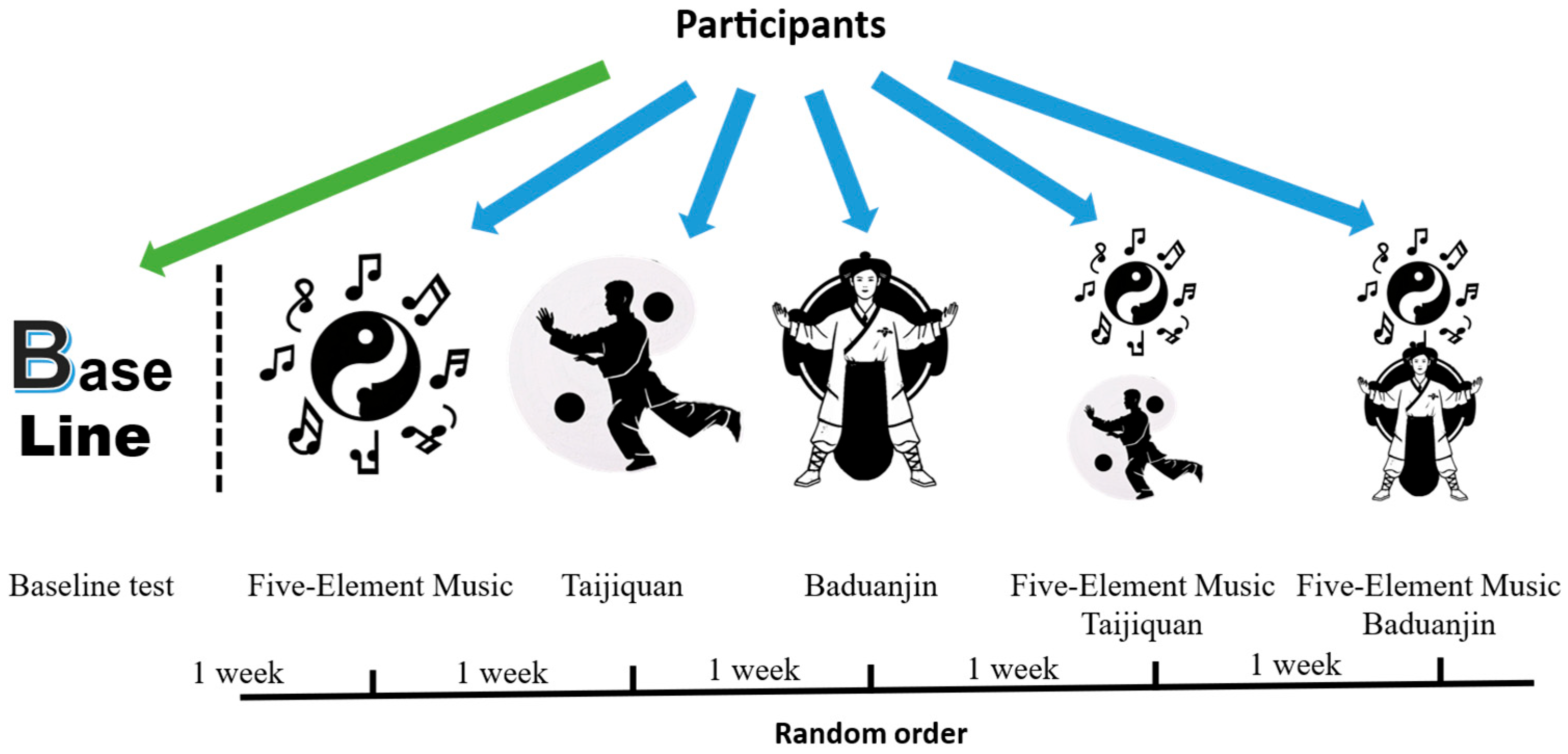
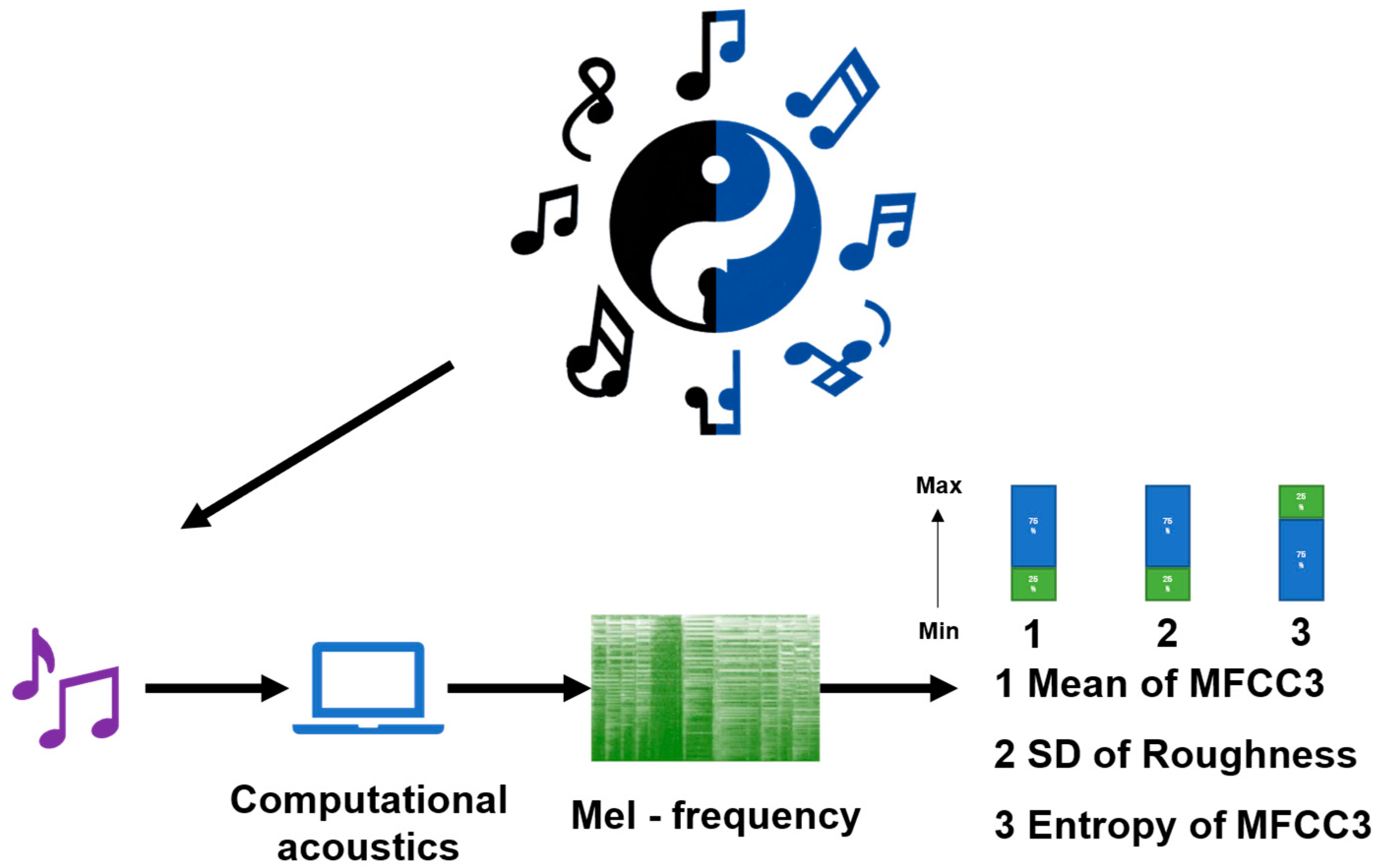
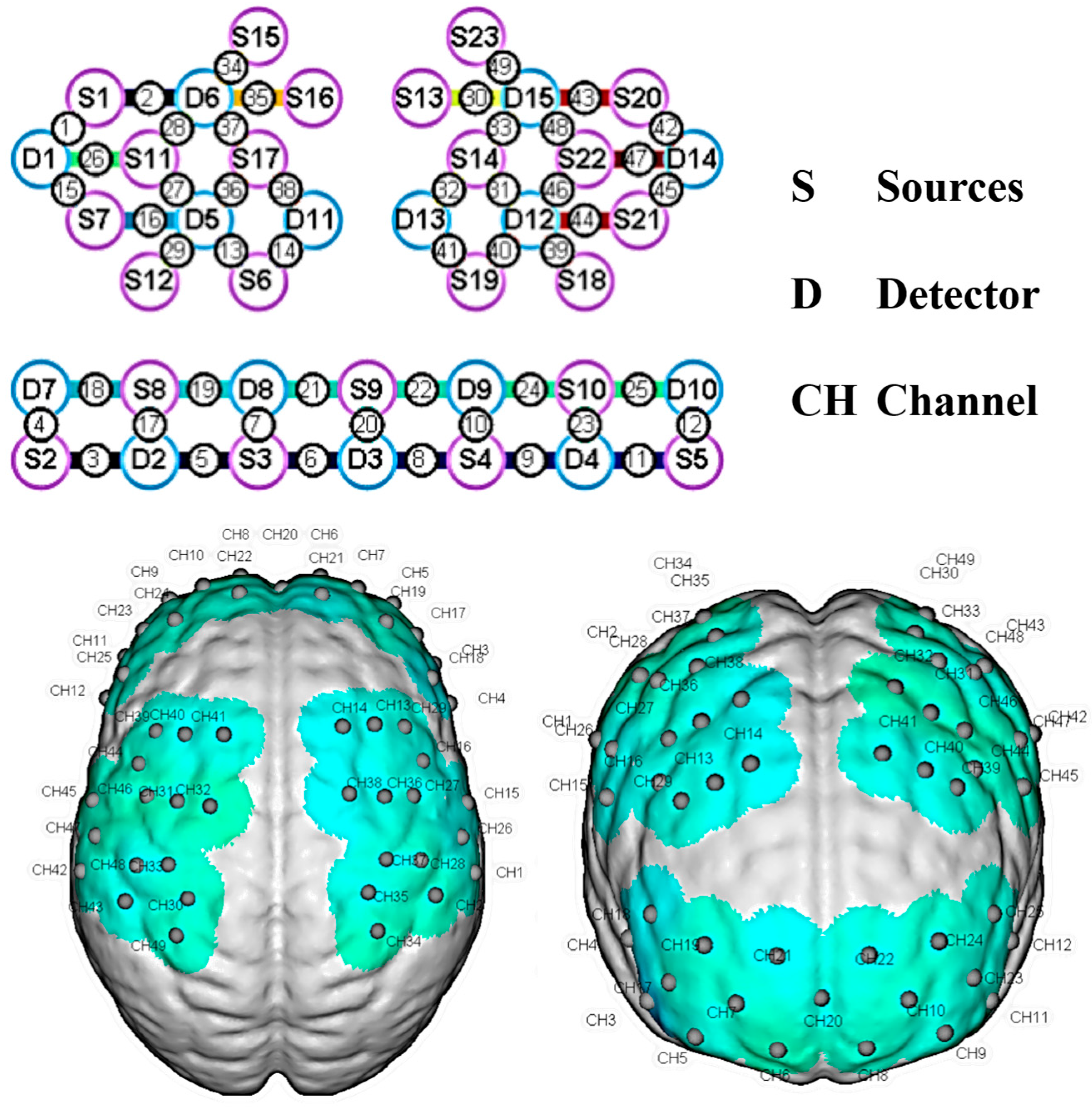
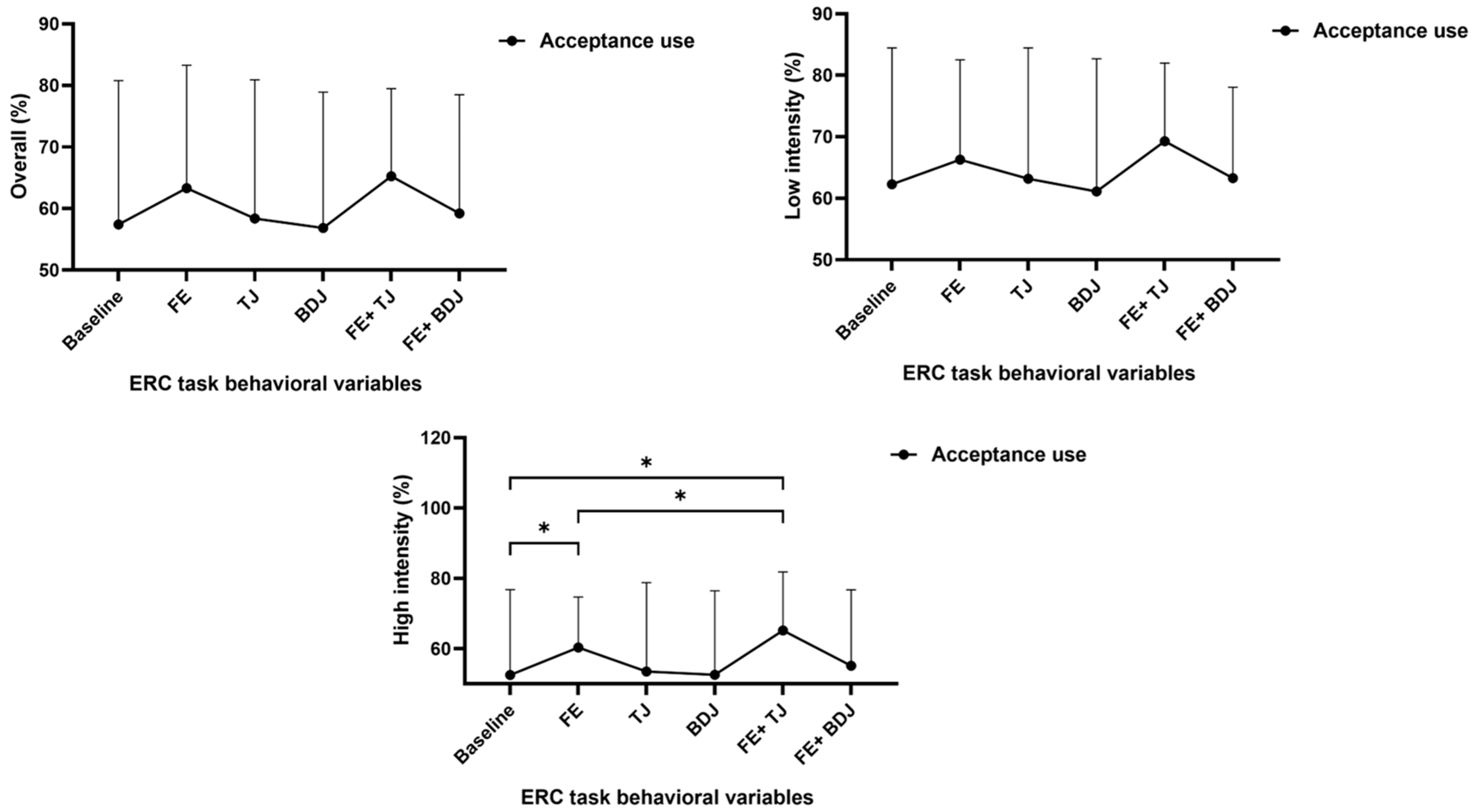
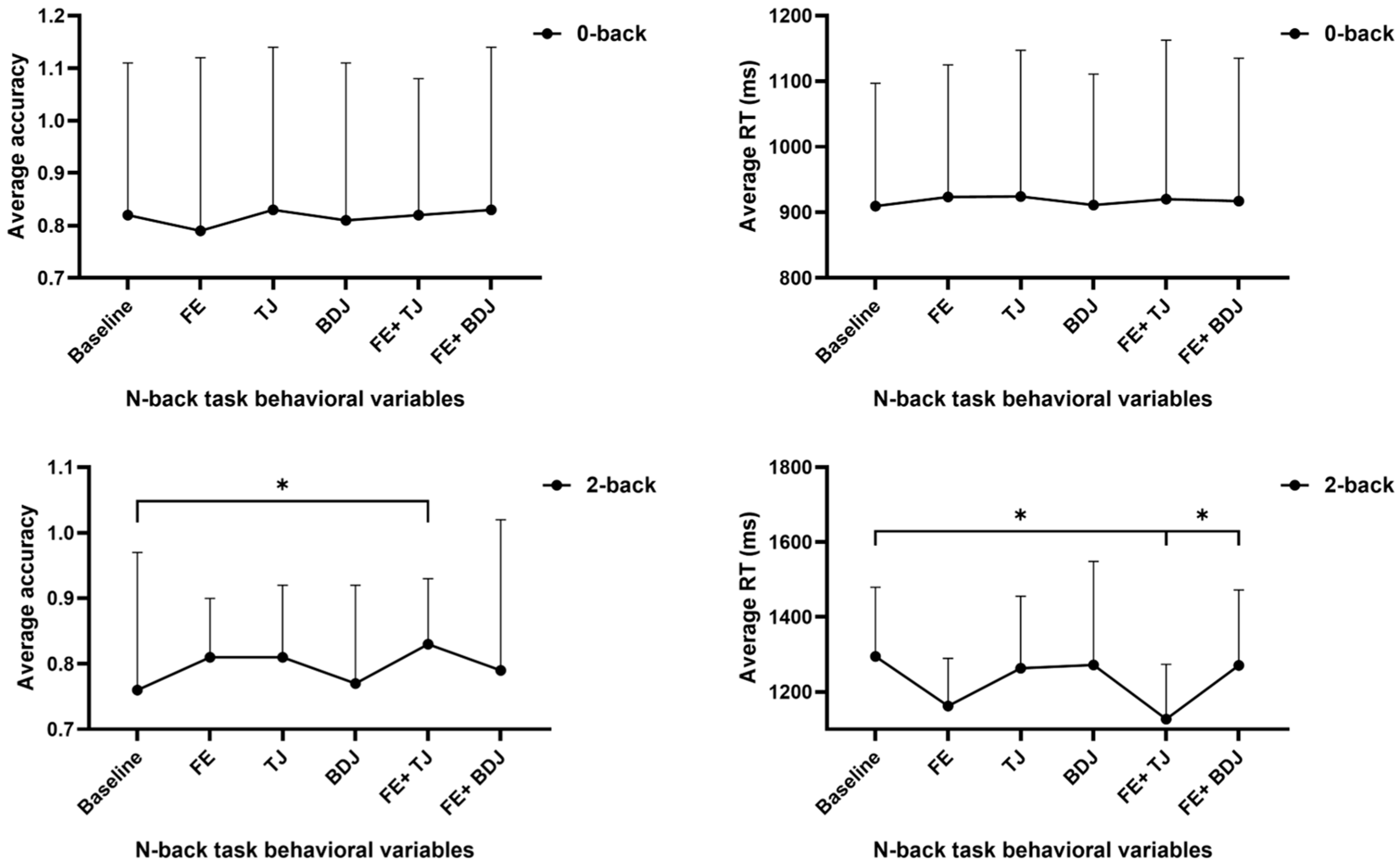

| Male (48%) | Female (52%) | |
|---|---|---|
| Age | 64.1 (3.2) | 65.0 (4.2) |
| BMI (kg/m2) | 24.35 (5.54) | 24.30 (6.70) |
| Education | ||
| <6 years | 5.7% | 19.5% |
| 6–9 years | 19.2% | 29.5% |
| 9–12 years | 26.7% | 32.2% |
| 12–16 years | 28.1% | 17.7% |
| >16 years | 20.3% | 1.1% |
| Baseline | FE | TJ | BDJ | FE+TJ | FE+BDJ | F | p | η²P | |
|---|---|---|---|---|---|---|---|---|---|
| Emotional regulation task behavioral variables | |||||||||
| Acceptance use: overall (%) | 57.41 (23.39) | 63.33 (19.95) | 58.37 (22.56) | 56.85 (22.07) | 67.24 (14.25) | 59.23 (19.24) | 1.096 | 0.364 | 0.026 |
| Acceptance use: low intensity (%) | 62.29 (22.15) | 66.29 (16.23) | 63.19 (21.26) | 61.13 (21.56) | 69.27 (12.72) | 63.29 (14.77) | 1.898 | 0.096 | 0.044 |
| Acceptance use: high intensity (%) | 52.54 (24.28) | 60.37 (14.34) | 53.54 (25.27) | 52.58 (23.88) | 65.21 (16.63) | 55.16 (21.59) | 4.659 | 0.001 | 0.102 |
| N-back task behavioral variables | |||||||||
| 0-back average accuracy | 0.82 (0.29) | 0.79 (0.33) | 0.83 (0.31) | 0.81 (0.30) | 0.82 (0.26) | 0.83 (0.31) | 0.981 | 0.430 | 0.023 |
| 0-back average RT (ms) | 909.36 (187.45) | 923.66 (201.29) | 924.12 (223.13) | 911.12 (199.72) | 920.31 (242.12) | 917.14 (217.91) | 0.330 | 0.894 | 0.008 |
| 2-back average accuracy | 0.76 (0.21) | 0.81 (0.09) | 0.81 (0.11) | 0.77 (0.15) | 0.83 (0.10) | 0.79 (0.23) | 4.202 | 0.001 | 0.093 |
| 2-back average RT (ms) | 1294.29 (185.35) | 1162.13 (127.14) | 1263.19 (192.19) | 1271.56 (276.48) | 1127.12 (146.29) | 1270.34 (201.43) | 5.354 | 0.001 | 0.115 |
| CH↔CH | FC Values | Condition | |||||||
|---|---|---|---|---|---|---|---|---|---|
| Baseline | FE | TJ | BDJ | FE+TJ | FE+BDJ | F | p | PFDR | |
| CH 45↔CH 9 | 0.25 (0.11) | 0.33 (0.15) | 0.12 (0.05) | 0.25 (0.11) | 0.83 (0.23) | 0.09 (0.07) | 10.23 | <0.001 | 0.008 |
| CH 29↔CH 6 | 0.04 (0.03) | 0.13 (0.07) | 0.15 (0.06) | 0.07 (0.04) | 0.79 (0.17) | 0.03 (0.02) | 9.87 | <0.001 | 0.012 |
| CH 45↔CH 11 | 0.08 (0.05) | 0.34 (0.08) | 0.26 (0.07) | 0.05 (0.04) | 0.13 (0.09) | 0.63 (0.21) | 8.55 | <0.001 | 0.015 |
Disclaimer/Publisher’s Note: The statements, opinions and data contained in all publications are solely those of the individual author(s) and contributor(s) and not of MDPI and/or the editor(s). MDPI and/or the editor(s) disclaim responsibility for any injury to people or property resulting from any ideas, methods, instructions or products referred to in the content. |
© 2025 by the authors. Licensee MDPI, Basel, Switzerland. This article is an open access article distributed under the terms and conditions of the Creative Commons Attribution (CC BY) license (https://creativecommons.org/licenses/by/4.0/).
Share and Cite
Zhao, J.; Li, H.; Wang, X. Effects of Acoustically Screened Five-Element Music Combined with Traditional Chinese Mind–Body Exercises on Emotion Regulation, Working Memory, and Functional Brain Connectivity in Older Adults: A Randomized Repeated-Measures Study. Behav. Sci. 2025, 15, 699. https://doi.org/10.3390/bs15050699
Zhao J, Li H, Wang X. Effects of Acoustically Screened Five-Element Music Combined with Traditional Chinese Mind–Body Exercises on Emotion Regulation, Working Memory, and Functional Brain Connectivity in Older Adults: A Randomized Repeated-Measures Study. Behavioral Sciences. 2025; 15(5):699. https://doi.org/10.3390/bs15050699
Chicago/Turabian StyleZhao, Junya, Haojie Li, and Xiaoyan Wang. 2025. "Effects of Acoustically Screened Five-Element Music Combined with Traditional Chinese Mind–Body Exercises on Emotion Regulation, Working Memory, and Functional Brain Connectivity in Older Adults: A Randomized Repeated-Measures Study" Behavioral Sciences 15, no. 5: 699. https://doi.org/10.3390/bs15050699
APA StyleZhao, J., Li, H., & Wang, X. (2025). Effects of Acoustically Screened Five-Element Music Combined with Traditional Chinese Mind–Body Exercises on Emotion Regulation, Working Memory, and Functional Brain Connectivity in Older Adults: A Randomized Repeated-Measures Study. Behavioral Sciences, 15(5), 699. https://doi.org/10.3390/bs15050699






